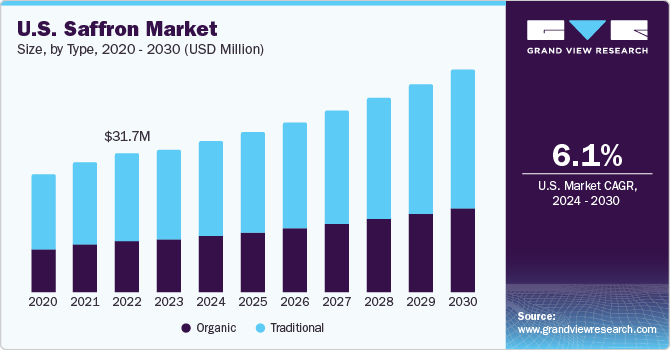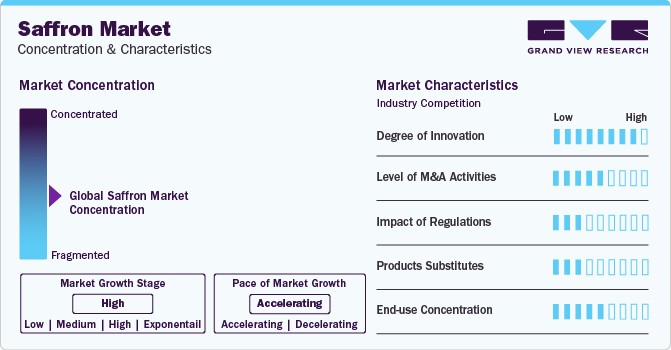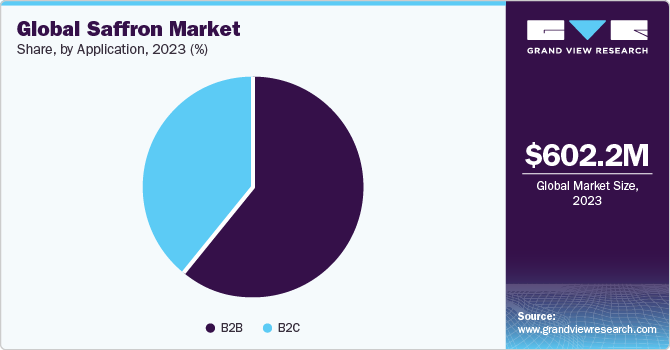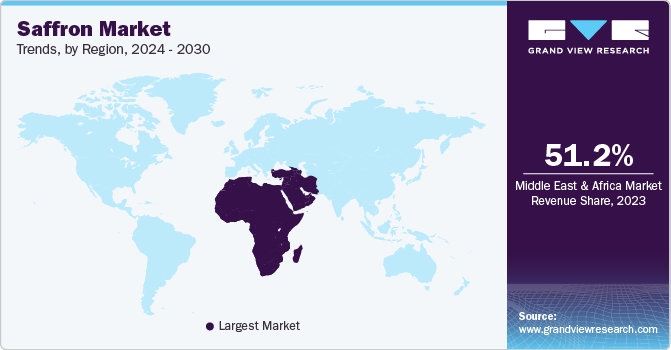- Home
- »
- Consumer F&B
- »
-
Saffron Market Size, Share, Trends & Growth Report, 2030GVR Report cover
![Saffron Market Size, Share & Trends Report]()
Saffron Market Size, Share & Trends Analysis Report By Grade (Grade-I, Grade-II, Grade-III, Grade-IV), By Application, By Type, By Form, By Distribution, By Region, And Segment Forecasts, 2024 - 2030
- Report ID: GVR-1-68038-471-0
- Number of Report Pages: 180
- Format: PDF, Horizon Databook
- Historical Range: 2017 - 2021
- Forecast Period: 2024 - 2030
- Industry: Consumer Goods
Saffron Market Size & Trends
The global saffron market was estimated at USD 602.2 million in 2023 and is expected to grow at a compound annual growth rate (CAGR) of 7.1% from 2024 to 2030. Growing demand for saffron in medical and cosmetic applications is expected to be a key driving factor for the market in the forecast period. Saffron is rich in antioxidants and offers several health benefits. The main active compounds present in saffron include picrocrocin, safranal, and crocin. These compounds help reduce oxidative damage and inflammation in the human brain. Furthermore, saffron is known for its memory-enhancing, antioxidant, and anti-inflammatory properties, which are likely to propel the growth of the market. Furthermore, it is used as a natural UV-absorbing agent in the cosmetics industry.

Key technologies used in processing include image processing technology, pilot scale, and electric nose. The process of separating stigmas has been done manually so far, however, using the image processing method to separate stigmas is less time-consuming. ISO Standard 3632 is the requirement that concerns merely the measurement of the quality. Adulteration has been growing rapidly in recent years owing to the high price and increased demand in the global market. The adulteration includes the mixing of products that look similar to saffron.
The market is expected to exhibit a low threat of new entrants on account of the extensive portfolio offered and distribution network operated by existing players, which results in a high entry barrier for new entrants. Besides, the high switching cost for the buyers makes it difficult for new players to gain a significant market share, thereby lowering the threat of new entrants.
The adulteration results in variations in the quality of the product and the consequent variation in prices. The standard comprises 2 parts, ISO 3632-1 and ISO 3632-2, which identify the test methods for various classifications of dried, cut threads, powders, and threads. The main purpose of the standards is to test the strength of flavor, scent, and color of saffron, which helps protect consumers from purchasing a fake product that is expensive as well as has no food value.
The U.S. has witnessed increasing demand over the past few years owing to the growing awareness among consumers about the medicinal properties and health benefits of saffron. The trade between Iran and the U.S. witnessed a surge after the U.S. revoked trade restrictions that were imposed on imports from Iran. Growers in the U.S. have been increasingly investing in cultivation. The growers from the states, such as Vermont, Pennsylvania, and Washington, have been taking initiatives with an aim to increase the product’s cost-effective domestic supply.
Market Characteristics
The saffron industry showcases a significant degree of innovation, marked by a continuous stream of fresh developments. Companies operating in this sector are proactively introducing inventive saffron-based products, formulations, and applications to keep pace with evolving consumer preferences.

The mergers and acquisitions are in the range of low to medium in the saffron industry. Companies undergoing mergers and acquisitions are seeking strategic partnerships to enhance their product portfolios, expand their market presence, and leverage each other’s strengths.
Regulatory authorities enforce precise labeling standards to ensure transparency and accurate information for consumers. This includes the disclosure of specific ingredients, their concentrations, and any potential allergens. Compliance with labeling regulations is crucial to building consumer trust and facilitating informed choices.
The substitutes of saffron include turmeric, marigold petals, and safflower. As the food industry evolves, ongoing research and innovation continue to explore new and improved color solutions that align with changing consumer preferences and regulatory landscapes.
Grade Insights
In the global market, the finest quality available is categorized as Grade I, which generated more than 60% of the total revenue in 2023. This segment includes two types of saffron: Negin and Sargol. Negin typically has an ISO reading of over 270, while Sargol's ISO reading ranges from 260 to 270. The reason for the Grade I segment's dominance is due to the excellent coloring and flavoring strengths and aroma of its products. These characteristics make Grade I saffron highly desirable for premium culinary applications, fragrances, and personal care products. It's high coloring and flavoring strength make it ideal for use in these premium products.
The rising trend of premium product consumption is driving up the demand for top-notch saffron, thereby propelling the growth of this market segment. To ensure authenticity and quality, saffron is evaluated according to the ISO 3632 standard, which assesses its grading, labeling, and packaging. The product's market value is determined by its grade and inspection results. Grade III saffron, which has a high safranal (fragrance) content, is widely used in cosmetics, personal care, and fragrance products.
Application Insights
The petals form led the global market with a revenue share of 51.7% in 2023. Petals are often used in traditional medicine and herbal remedies, as they are believed to have several health benefits, such as reducing inflammation and improving mood. In addition, the use of saffron petals is in the production of natural dyes. Saffron petals contain a yellow-orange pigment called crocin, which can be extracted and used to color fabrics and other materials.
The market for liquid form is expected to witness significant CAGR over the projected period. Saffron liquid is an extract of saffron spice that is used in a variety of ways for its unique flavor, aroma, and color. It is often used in cooking to add a distinctive flavor to dishes and is particularly popular in Mediterranean and Middle Eastern cuisine. Saffron liquid is also used in traditional medicine as it is believed to have various health benefits, including anti-inflammatory and antioxidant properties.
In addition to its culinary and medicinal uses, saffron liquid is also used in the perfume industry to add a unique and exotic aroma to fragrances. It is also used in the textile industry to dye fabrics and give them a bright yellow or orange color.
In April 2022, Lisnor now offers a saffron liquid detergent with effective stain removal. They're expanding their lineup with a 3L bottle and fragrance-free detergent for baby clothes, and 3 in 1 washing pods with natural saffron extract.
Type Insights
The traditional type led the global market with a revenue share of 63.6% in 2023. The market for traditional saffron harvest is driven by several factors, including its unique flavor, aroma, and color, which make it a highly valued ingredient in cooking, cosmetics, and traditional medicine. In addition to its culinary uses, saffron has been used for centuries in traditional medicine to treat a variety of ailments, including depression, anxiety, and menstrual cramps. It is also used in cosmetics for its skin-brightening properties.
Organic type in saffron market is expected to witness significant CAGR over the projected period. Organic saffron is becoming increasingly popular due to the growing demand for natural and healthy food products. Organic saffron is produced using natural methods of cultivation that do not involve the use of synthetic fertilizers or pesticides. This makes it a healthier and more environmentally friendly choice for consumers.
Distribution Channel Insights
The B2B distribution channel is expected to grow at a revenue CAGR of 6.9% from 2024 to 2030 with a market share of 237.60 million in 2023. The growing trend of using saffron as a natural coloring and flavoring agent in food and beverages is particularly contributing to the expansion of the market for saffron in the B2B distribution channel.

The market for B2C distribution channel is expected to witness significant CAGR during the projected period. In the B2C distribution channel, several factors are driving market growth, including the increasing availability of saffron products through online retail channels, the growing popularity of saffron-based supplements and dietary products, and the increasing use of saffron in the cosmetics and personal care industries. Additionally, the rise of e-commerce platforms has made it easier for consumers to purchase saffron products directly from manufacturers, leading to increased competition and lower prices.
Regional Insights
Middle East and Africa held a revenue share of 51.2% in 2023. This is attributable to the increasing demand for its use in traditional cuisine. Saffron is an essential ingredient in many dishes in the region, such as biryanis, pilafs, and tagines, and it is also used to flavor sweets and desserts. The spice is a symbol of hospitality and is often served to guests as a sign of respect. Another factor driving the saffron industry in the region is its medicinal properties. Saffron has been used for centuries in traditional medicine to treat a range of ailments, including depression, anxiety, and insomnia. It is also believed to have antioxidant and anti-inflammatory properties and may help to lower blood pressure and cholesterol levels.

In November 2022, Iran established a gene bank for saffron bulbs to identify and register a particular species of Iranian saffron with the United Nations' Food and Agriculture Organization. The gene bank has gathered saffron bulbs from 57 different regions in Iran and plans to continue expanding its collection in the future. This initiative aims to safeguard and preserve the genetic diversity of saffron bulbs in Iran for future generations.
North America is expected to expand at a revenue CAGR of 6.7% during the forecast period. Saffron is becoming increasingly popular in North America due to its various health benefits. Modern lifestyles have resulted in anxiety attacks becoming increasingly common among adults, and saffron is highly effective in treating them. Saffron tablets contain bioactive compounds such as Crocin, which possess several medicinal properties and health benefits.
Europe is expected to grow at a CAGR of 7.2% during the forecast period. The increasing awareness of the health benefits of saffron, coupled with the rising demand for organic and natural products, is driving the growth of the market in Europe. As a result, there is a growing demand for high-quality saffron from consumers, which is fueling the growth of the market in Europe.
According to an article published on BIOPRO Baden-Württemberg GmbH, a German start-up, Innovation Matters, is developing a robot-assisted process for saffron cultivation. The robot, named Oscar, can detect, and cut flowers, but extraction of saffron threads still needs to be done by hand. Germany could potentially become a net exporter of saffron. The company plans to make test products available soon and collect data from real customers.
Asia Pacific is expected to expand at a revenue CAGR of 7.3% during the forecast period. The market for saffron in Asia Pacific is driven by a variety of factors, including its cultural and historical significance, its use in traditional medicine and culinary applications, and its increasing popularity as a premium ingredient in luxury products. In many Asian countries like India and China, saffron has been used for centuries in traditional medicine for its various health benefits, such as improving digestion, treating respiratory ailments, and reducing inflammation. It is also believed to have mood-enhancing properties and is used in Ayurvedic medicine and other traditional healing systems.
Key Saffron Company Insights
The global market is dominated by a small number of players, with production primarily concentrated in Middle Eastern countries. However, there is significant potential for emerging and new players in need of comprehensive support throughout the value chain. Both established and new market participants are increasingly emphasizing strong brand management to improve key differentiators, such as portfolio diversity, and competitive pricing. Additionally, consumers favor buying Saffron through B2C sales channels. As a result, manufacturers in the industry are introducing online platforms for delivering consistent and bulk quantities to home chefs and domestic use.
Major players in the market are introducing new products and are focusing on strategic partnerships, product launches, mergers, joint ventures, and acquisitions to increase their market share.
-
In June 2023, Spanish biotech company Natac has acquired French firm Inoreal to expand its saffron product range. Inoreal's brands Satieral, effective for weight loss, and Moodreal will be used for this purpose. Natac expects an eight-fold increase in saffron output over the next three years and plans to explore opportunities in Latin America.
-
In June 2022, SoulTree, a brand specializing in Ayurvedic beauty and wellness products, launched its Advanced Kumkumadi line of products. This range is created using only 100% pure, certified organic Mogra Saffron and is developed with the fundamental principles of Ayurvedic traditions.
-
In October 2022, USMS Saffron Co., a supplier of saffron in India, plans to expand its business beyond the spice market and launch health-oriented food and beverages, including saffron drinks and supplements.
-
In November 2022, Veggitech opened a Saffron farm in the Mena region in Sharjah, UAE, using smart built-in systems to manage the farming process. Farm is aligned with the UAE's National Food Security Strategy for 2051.
Key Saffron Companies:
The following are the leading companies in the saffron market. These companies collectively hold the largest market share and dictate industry trends. Financials, strategy maps & products of these saffron companies are analyzed to map the supply network
- Esfedan Trading Company
- Safran Global Company S.L.U.
- Tarvand Saffron Co.
- Saffron Business Company
- Gohar Saffron
- Rowhani Saffron Co.
- Mehr Saffron
- Flora Saffron
- Royal Saffron Company
- Iran Saffron company
Saffron Market Report Scope
Report Attribute
Details
The market size value in 2024
USD 635.67 million
The revenue forecast in 2030
USD 959.38 million
Growth Rate
CAGR of 7.1% from 2024 to 2030
Base year for estimation
2023
Historical data
2017 - 2022
Forecast period
2024 - 2030
Quantitative units
Revenue in USD million and CAGR from 2024 to 2030
Report coverage
Revenue Forecast, Company Ranking, Competitive Landscape, Growth Factors, and Trends
Segments covered
Grade, type, form, application, distribution, regions
Regional scope
North America; Europe; Asia Pacific; Central & South America; Middle East & Africa
Country scope
U.S.; Canada; Mexico; U.K.; Germany; France; Italy; China; India; Japan; Brazil; Argentina; South Africa; UAE; Iran
Key companies profiled
Esfedan Trading Company; Safran Global Company S.L.U.; Tarvand Saffron Co.; Saffron Business Company; Gohar Saffron; Rowhani Saffron Co.; Mehr Saffron; Flora Saffron; Royal Saffron Company; Iran Saffron company
Customization scope
Free report customization (equivalent up to 8 analysts working days) with purchase. Addition or alteration to country, regional & segment scope.
Pricing and purchase options
Avail customized purchase options to meet your exact research needs. Explore purchase options
Global Saffron Market Report Segmentation
This report forecasts revenue growth at regional levels and provides an analysis on the latest trends and opportunities in each of the sub-segments from 2017 to 2030. For this study, Grand View Research has segmented the saffron market based on grade, type, form, application, distribution channel, and region.
-
Grade Outlook (USD Million; Tons; 2017 - 2030)
-
Grade I
-
Grade II
-
Grade III
-
Grade IV
-
-
Type Outlook (USD Million; Tons; 2017 - 2030)
-
Organic
-
Traditional
-
-
Form Outlook (USD Million; Tons 2017 - 2030)
-
Liquid
-
Powder
-
Stigma
-
Petals
-
Stamen
-
-
Application Outlook (USD Million; Tons; 2017 - 2030)
-
Food supplements
-
Cosmetics
-
Personal care products
-
Food & beverage
-
Others
-
-
Distribution Channel Outlook (USD Million; Tons; 2017 - 2030)
-
B2B
-
B2C
-
-
Regional Outlook (Revenue, USD Million; Tons; 2017 - 2030)
-
North America
-
U.S.
-
Canada
-
Mexico
-
-
Europe
-
U.K.
-
Germany
-
France
-
Italy
-
-
Asia Pacific
-
China
-
India
-
Japan
-
Australia & New Zealand
-
-
Central & South America
-
Brazil
-
Argentina
-
-
Middle East & Africa
-
South Africa
-
UAE
-
Iran
-
-
Frequently Asked Questions About This Report
b. The global saffron market size was estimated at USD 602.2 million in 2023 and is expected to reach USD 635.7 million in 2024.
b. The saffron market is expected to grow at a compound annual growth rate of 7.1% from 2024 to 2030, to reach USD 959.38 million by 2030.
b. The food & beverages segment dominated the saffron market in 2023 with a share of 58.1% and is expected to grow at a CAGR of 6.7% through to 2030.
b. Some of the key players in the saffron market are Esfedan Trading Company, Safran Global Company S.L.U., Tarvand Saffron Co., Saffron Business Company, Gohar Saffron, Rowhani Saffron Co., Mehr Saffron, Flora Saffron, Royal Saffron Company, and Iran Saffron Company.
b. Growing demand for saffron in medical and cosmetic applications is expected to be a key driving factor for the saffron market in the forecast period, given its richness in antioxidants and the several health benefits offered.
Share this report with your colleague or friend.
![gvr icn]()
NEED A CUSTOM REPORT?
We can customize every report - free of charge - including purchasing stand-alone sections or country-level reports, as well as offer affordable discounts for start-ups & universities. Contact us now
![Certified Icon]()
We are GDPR and CCPA compliant! Your transaction & personal information is safe and secure. For more details, please read our privacy policy.
We are committed towards customer satisfaction, and quality service.
"The quality of research they have done for us has been excellent."





